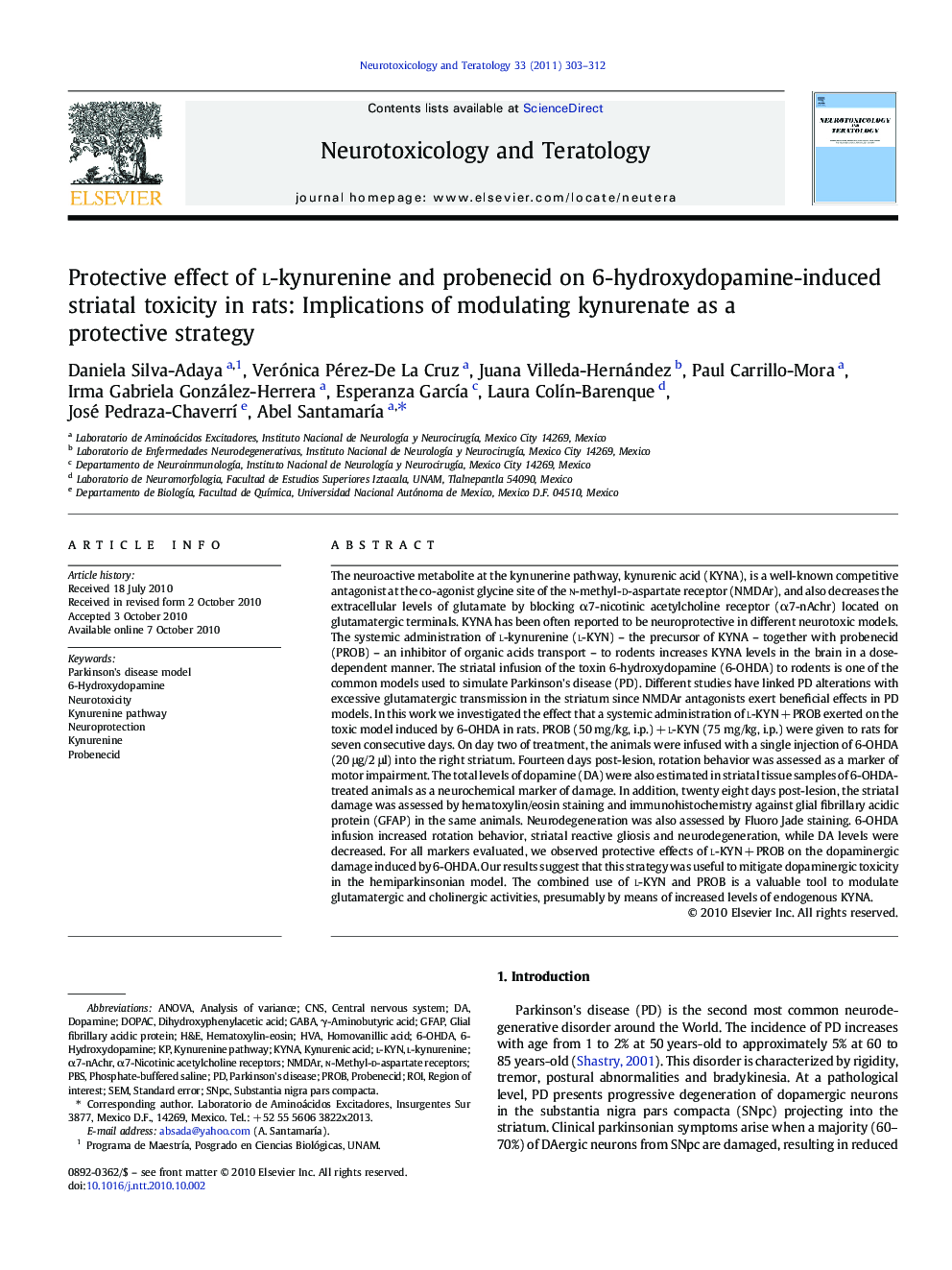| کد مقاله | کد نشریه | سال انتشار | مقاله انگلیسی | نسخه تمام متن |
|---|---|---|---|---|
| 2591636 | 1131819 | 2011 | 10 صفحه PDF | دانلود رایگان |

The neuroactive metabolite at the kynunerine pathway, kynurenic acid (KYNA), is a well-known competitive antagonist at the co-agonist glycine site of the n-methyl-d-aspartate receptor (NMDAr), and also decreases the extracellular levels of glutamate by blocking α7-nicotinic acetylcholine receptor (α7-nAchr) located on glutamatergic terminals. KYNA has been often reported to be neuroprotective in different neurotoxic models. The systemic administration of l-kynurenine (l-KYN) – the precursor of KYNA – together with probenecid (PROB) – an inhibitor of organic acids transport – to rodents increases KYNA levels in the brain in a dose-dependent manner. The striatal infusion of the toxin 6-hydroxydopamine (6-OHDA) to rodents is one of the common models used to simulate Parkinson's disease (PD). Different studies have linked PD alterations with excessive glutamatergic transmission in the striatum since NMDAr antagonists exert beneficial effects in PD models. In this work we investigated the effect that a systemic administration of l-KYN + PROB exerted on the toxic model induced by 6-OHDA in rats. PROB (50 mg/kg, i.p.) + l-KYN (75 mg/kg, i.p.) were given to rats for seven consecutive days. On day two of treatment, the animals were infused with a single injection of 6-OHDA (20 μg/2 μl) into the right striatum. Fourteen days post-lesion, rotation behavior was assessed as a marker of motor impairment. The total levels of dopamine (DA) were also estimated in striatal tissue samples of 6-OHDA-treated animals as a neurochemical marker of damage. In addition, twenty eight days post-lesion, the striatal damage was assessed by hematoxylin/eosin staining and immunohistochemistry against glial fibrillary acidic protein (GFAP) in the same animals. Neurodegeneration was also assessed by Fluoro Jade staining. 6-OHDA infusion increased rotation behavior, striatal reactive gliosis and neurodegeneration, while DA levels were decreased. For all markers evaluated, we observed protective effects of l-KYN + PROB on the dopaminergic damage induced by 6-OHDA. Our results suggest that this strategy was useful to mitigate dopaminergic toxicity in the hemiparkinsonian model. The combined use of l-KYN and PROB is a valuable tool to modulate glutamatergic and cholinergic activities, presumably by means of increased levels of endogenous KYNA.
Research Highlights
► In this manuscript we confirmed previous evidence demonstrating that 6-OHDA is able to induce severe behavioral, morphological and neurochemical alterations to rats.
► We also collected evidence showing that the combined treatment of rats with PROB + l-KYN prevented these alterations in partial or complete manners.
► We then assumed that the mechanism of protection exerted by this combined treatment is related with increased endogenous levels of KYNA, based on literature demonstrating this event.
► Our results also support an active role of exhacerbated glutamatergic activity as part of the toxic pattern elicited by 6-OHDA in the striatum. In this regard, PROB + l-KYN treatment is suggested to mediate modulation on α7-nAchr and NMDAr function through potentially formed KYNA, thereby controlling excessive glutamate function.
Journal: Neurotoxicology and Teratology - Volume 33, Issue 2, March–April 2011, Pages 303–312